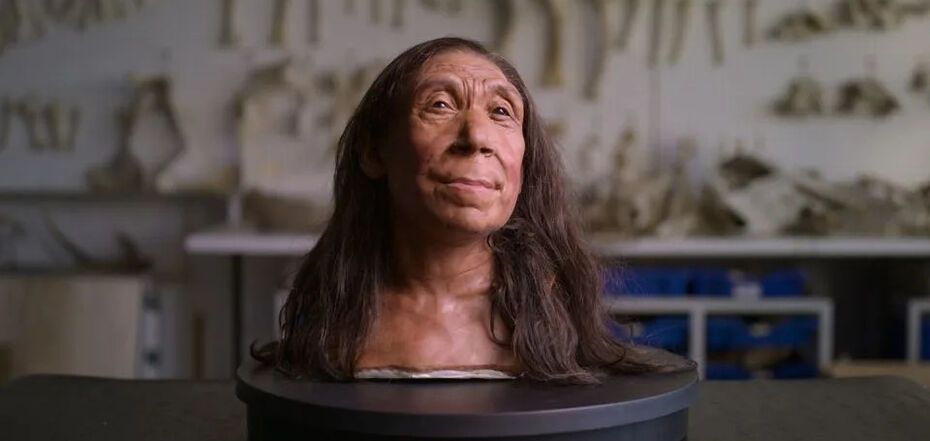News
Scientists have shown what a woman looked like 75 thousand years ago. Photo
Scientists have found the grave of a person who was buried in a cave 75,000 years ago. According to archaeologists, the woman died at the age of about 40.
Her left arm was twisted under her head, and her head was lying on a stone, which probably served as a pillow, Cambridge Core writes. The woman was a Neanderthal, a type of ancient human that has not lived on Earth for almost fifty thousand years.
The ancient woman was named Shanidar Z. in honor of the cave in Iraqi Kurdistan where she was found in 2018.
Scientists studying the remains of an ancient human carefully assembled the skull from 200 bone fragments. This process took nine months.
The contours of the face and skull were used for reconstruction to understand what she might have looked like. The reconstruction is featured in the new documentary Secrets of the Neanderthals, produced by the BBC for Netflix.
According to Dr. Emma Pomeroy, a paleoanthropologist and associate professor of archaeology at the University of Cambridge, Neanderthal skulls differ from those of our species (Homo sapiens) in having pronounced brow arches and no chin.
Instead, the reconstruction of Shanidar Z.'s face shows that these differences might not have been so striking in life, Pomeroy says.
"There's some artistic freedom here, but it's based on a real skull and real data about what we know about these people," the scientist said.
"In fact, she has quite a large face and brow arches for her size," Pomeroy added.
The researcher believes that if she were dressed in modern clothes, this might not be noticed.
Neanderthals lived in Europe, the Middle East, and the mountains of Central Asia for about 300,000 years. This is about 30,000 years earlier than Homo sapiens.
DNA analysis of modern humans has shown that during this time, Neanderthals and Homo sapiens interbred with each other from time to time.
Lived a long life
The sex of the skeleton was not immediately discovered, as only the upper half of the body was preserved. The team that initially studied the remains relied on a new technique involving sequencing proteins inside tooth enamel.
Analysis of tooth and bone wear showed that she was about 40 years old at the time of her death.
"It's a reasonable estimate, but we can't be 100% sure that she wasn't older. But this person probably lived a relatively long life. For that society, she was probably honored because of her knowledge and life experience," Pomeroy says.
The cave where Shanidar Z. was buried is well-known among archaeologists. A Neanderthal grave discovered there in 1960 led researchers to believe that ancient tribes could bury their dead with flowers.
This is the first challenge to the stereotype of the primitiveness of ancient people.
However, further research by Pomeroy's team cast doubt on the theory of burial with flowers. The pollen found among the graves could have gotten there through pollinating bees.
Over the years, however, scientists have found more and more evidence of Neanderthal intelligence, sophistication, and complexity, including art, strings, and tools.
Neanderthals repeatedly returned to Shanidar Cave to bury their dead. The remains of 10 Neanderthals were found at the site, half of which appear to have been buried on purpose and in succession.
Neanderthals may not have honored their dead with bouquets, but the inhabitants of Shanidar Cave must have been empathetic people. For example, one Neanderthal man buried there was deaf, and had a paralyzed arm and a head injury that probably made him partially blind, but he lived a long time. This indicates that he was probably well cared for.
Shanidar Z. is the first Neanderthal to be found in a cave in 50 years. But this place can bring even more discoveries. While filming a documentary in 2022, Pomeroy discovered a left shoulder blade, several rib bones, and a right arm that belonged to another Neanderthal.
Skull reconstruction
Pomeroy described the reconstruction of Shanidar Z.'s skull, which was crushed relatively soon after his death, as a "3D puzzle." The fossilized bones were hardened with a glue-like substance, extracted in small blocks from the cave sediment, and wrapped in foil before the researchers sent them to the University of Cambridge for analysis.
At the Cambridge lab, the researchers took micro-CT scans of each block and used the scans to guide the extraction of the bone fragments. Pomeroy's colleague, Dr. Lucia López-Polin, an archaeological conservator at the Catalan Institute of Paleoecology and Human Social Evolution in Spain, collected more than 200 skull fragments by eye to restore them to their original shape.
The team scanned and 3D-printed the restored skull, which formed the basis of a reconstructed head created by Dutch paleo-artists Adri and Alphonse Kennis, twin brothers who built up layers of artificial muscle and skin to reveal Shanidar Z's face.
Pomeroy said the reconstruction helped "bridge the gap between anatomy and 75,000 years of time."
Only verified information is available on the OBOZ.UA Telegram channel and Viber. Do not fall for fakes!





























